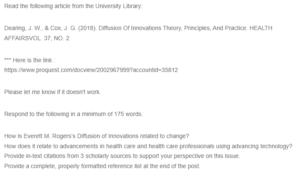Everett M. Rogers’s Diffusion of Innovations Theory
The Diffusion of Innovations Theory, created by Everett M. Rogers, is related to change as it explains how an innovative idea or a technology spreads within a population. Everett M. Rogers analyzed how innovations were passed and shared across communities through various channels (García-Avilés, 2020). Rogers identified that the process of innovation diffusion among individuals within a social system included awareness, interest, persuasion, decision, adoption, and confirmation. Rogers further divided the elements of sharing innovation into innovators, early adopters, early majority, late majority, and laggards (García-Avilés, 2020). Therefore, during change that includes the adoption of technologies and innovative processes, Roger’s Diffusion of Innovation can provide a framework for ensuring successful technology adoption.
Innovations in healthcare practices and adopting technologies in care delivery have led to a paradigm shift in healthcare. The adoption of digital technologies and innovations in healthcare has improved operational efficiency, the development of patient-centered practices, and efficiency in organizational management with an impact on socio-economic aspects of healthcare and is to provide maximum benefits to patients and healthcare organizations (Kraus et al., 2021). The healthcare environment has faced multiple problems and challenges, ranging from new complex diseases to regulations requiring constant innovations. Innovations such as using new technologies, health informatics, new research findings, data analytics, and new approaches to disease management will completely transform healthcare and disease management (Bucci et al., 2019). Everett M. Rogers’ Diffusion of Innovations, due to its description of innovations spread across communities and populations and the various facilitators and barriers to the innovation spread, the theory provides a framework for sharing innovations to manage diseases and pandemics globally in real-time.
References
Bucci, S., Schwannauer, M., & Berry, N. (2019). The digital revolution and its impact on mental health care. Psychology and Psychotherapy: Theory, Research, and Practice, 92(2), 277–297. https://doi.org/10.1111/PAPT.12222
García-Avilés, J. A. (2020). Diffusion of Innovation. The International Encyclopedia of Media Psychology, 1–8. https://doi.org/10.1002/9781119011071.IEMP0137
Kraus, S., Schiavone, F., Pluzhnikova, A., & Invernizzi, A. C. (2021). Digital transformation in healthcare: Analyzing the current state-of-research. Journal of Business Research, 123, 557–567. https://doi.org/10.1016/J.JBUSRES.2020.10.030
ORDER A PLAGIARISM-FREE PAPER HERE
We’ll write everything from scratch
Question

Everett M. Rogers’s Diffusion of Innovations Theory
Read the following article from the University Library:
Dearing, J. W., & Cox, J. G. (2018). Diffusion Of Innovations Theory, Principles, And Practice. HEALTH AFFAIRSVOL. 37, NO. 2
*** Here is the link :
https://www.proquest.com/docview/2002967999?accountid=35812
Please let me know if it doesn’t work.
Respond to the following in a minimum of 175 words:
How is Everett M. Rogers’s Diffusion of Innovations related to change?
How does it relate to advancements in health care and health care professionals using advancing technology?
Provide in-text citations from 3 scholarly sources to support your perspective on this issue.
Provide a complete, properly formatted reference list at the end of the post.

